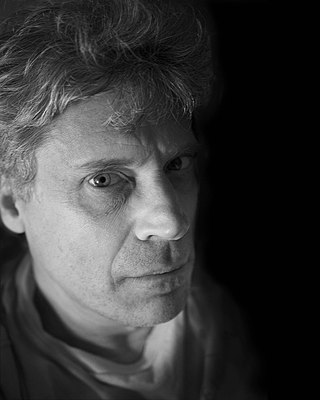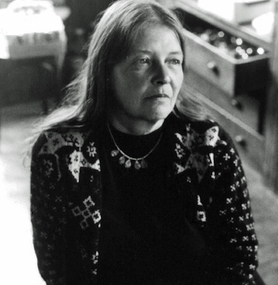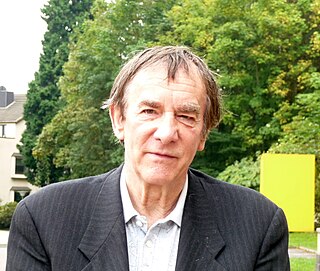Career
Her paintings are in the collections of the Minneapolis Institute of Arts, Delaware Art Museum, Columbus Museum of Art, National Museum of Women in the Arts, Pennsylvania Academy of the Fine Arts, Farnsworth Art Museum, Frederick R. Weisman Art Museum, and New Orleans Museum of Art. [3]
Her works have been reviewed by critics in art publications including Artforum , D’Art International, [4] Arts Magazine [5] and the Helsingin Sanomat. [6]
The American artist and art dealer Betty Parsons was a mentor in Bradley's early career. [7] The collectors The late Herbert Vogel and Dorothy Vogel have been mentors of her work, and Bradley’s paintings and drawings from the Vogel collection are currently being exhibited in museums in the United States as part of the Vogel 50/50 collaboration sponsored by the National Gallery of Art.
Currently living and working in New York, where she has been based since the late 1970s, Bradley is known for the dynamic interaction of line, plane, and space in her paintings. Having developed an individualized formal vocabulary, the artist achieves an expression of simultaneous movement and stillness. [8] Her painting creates a feeling of suspended time or, as an art critic, Carter Ratcliff commented, "a pause between the pulses of some vast and luminous energy." [9] A reproduction of her work appears in the seminal art history text, The Art of Seeing, 3rd through 6th editions, published by Prentice Hall. [10]

The Gates of Hell is a monumental bronze sculptural group work by French artist Auguste Rodin that depicts a scene from the Inferno, the first section of Dante Alighieri's Divine Comedy. It stands at 6 metres high, 4 metres wide and 1 metre deep (19.7×13.1×3.3 ft) and contains 180 figures.

Amy Sillman is a New York-based visual artist, known for process-based paintings that move between abstraction and figuration, and engage nontraditional media including animation, zines and installation. Her work draws upon art historical tropes, particularly postwar American gestural painting, as both influences and foils; she engages feminist critiques of the discourses of mastery, genius and power in order to introduce qualities such as humor, awkwardness, self-deprecation, affect and doubt into her practice. Profiles in The New York Times, ARTnews, Frieze, and Interview, characterize Sillman as championing "the relevance of painting" and "a reinvigorated mode of abstraction reclaiming the potency of active brushwork and visible gestures." Critic Phyllis Tuchman described Sillman as "an inventive abstractionist" whose "messy, multivalent, lively" art "reframes long-held notions regarding the look and emotional character of abstraction."
David Ratcliff is a painter based in Los Angeles. His work involves spray painting on collages using appropriated images.

Marcia Tucker was an American art historian, art critic and curator. In 1977 she founded the New Museum of Contemporary Art, a museum dedicated to innovative art and artistic practice in New York City, which she ran as the director until 1999.

David Em is an American artist known for his pioneering breakthroughs in computer art.

Shot Marilyns is a series of silkscreen paintings produced in 1964 by Andy Warhol, each canvas measuring 40 inches square, and each a portrait of Marilyn Monroe.
Serial art is an art movement in which uniform elements or objects were assembled in accordance with strict modular principles. The composition of serial art is a systematic process.

Lynne Mapp Drexler was an American abstract and representational artist, painter and photographer.

Thomas Lawson is an artist, writer, editor, and from 1991 to 2022 was the Dean of the School of Art & Design at California Institute for the Arts. He emerged as a central figure in ideological debates at the turn of the 1980s about the viability of painting through critical essays, such as "Last Exit: Painting" (1981). He has been described as "an embedded correspondent [and] polemical editorialist" who articulated an oppositional, progressive position for representational painting from within an increasingly reactionary art and media environment. Artforum called his approach to the medium "one of the most cogent and controversial" in the 80s.

Herbert Vogel and Dorothy Vogel, once described as "proletarian art collectors," worked as civil servants in New York City for more than a half-century while amassing what has been called one of the most important post-1960s art collections in the United States, mostly of minimalist and conceptual art. Herbert Vogel died on July 22, 2012, in a Manhattan nursing home.
Charles Sidney Clough is an American painter. His art has been exhibited in over 70 solo and over 150 group exhibitions throughout North America and Europe and is included in the permanent collections of over 70 museums, including the Metropolitan Museum of Art, National Gallery of Art, and Smithsonian American Art Museum. Clough has received fellowships and grants from the New York State Council on the Arts, National Endowment for the Arts, Adolph and Esther Gottlieb Foundation, the Pollock-Krasner Foundation, and the John Simon Guggenheim Foundation.
Nancy Marmer is a writer, art critic and editor who lives in New York City.

Mary Heilmann is an American painter based in New York City and Bridgehampton, NY. She has had solo shows and travelling exhibitions at galleries such as 303 Gallery and Hauser & Wirth (Zurich) and museums including the Wexner Center for the Arts and the New Museum. Heilmann has been cited by many younger artists, particularly women, as an influential figure.
Nancy Dwyer is an American contemporary artist whose works include paintings, works on paper, public art, word sculpture and furniture art. Her work has been exhibited widely at venues including the Whitney Museum of American Art, the Museum of Contemporary Art, Los Angeles, the Contemporary Arts Museum in Houston, the New Museum in New York and many others. Her work was included in the 2009 exhibition “The Pictures Generation” at the Metropolitan Museum of Art in New York, alongside the work of her peers and contemporaries, including Cindy Sherman and Robert Longo, with whom she cofounded Hallwalls in Buffalo, New York in 1974, as well as work by Barbara Kruger, Richard Prince, John Baldessari, Louise Lawler and Sherrie Levine, among others.
Joan Nelson is a visual artist who lives and works in upstate New York. For over three decades, Nelson has been making "epic and theatrical landscape paintings," borrowing from art history and re-presenting iconic vistas from the Fine Art lexicon including those of the Hudson River and Mount Hood. Joan Nelson spent her youth in St. Louis, Missouri, and "emerged from the East Village in the mid-‘80s at the forefront of a landscape revival that blurred the line between romance and irony.” Now, as then, Nelson paints small paintings on thick pieces of wood using a variety of materials such as oil paint and glitter, often combined with wax. She is well known for incorporating multiple pictorial landscape traditions in her vistas, combining fragments of paintings by other artists including those of artists: Hergé, who illustrated Tintin, Albrecht Altdorfer, Albert Bierstadt, Edward Hicks, Caspar David Friedrich, and George Caleb Bingham. This "referential vocabulary" demonstrates that Nelson's "landscape painting is not about the imitation of nature, or verisimilitude, but about art.” Occupying a unique place in the long history of landscape painting, Nelson "speaks to the experience of nature and the complexity of its representation across time and place... one that is distinctly female and revisionist." Her work has been described as "apocalyptic, with critics uncertain whether she is showing us an end or a potential beginning."
Edda Renouf is an American painter and printmaker. Renouf creates minimalist abstract paintings and drawings developed from her close attention to subtle properties of materials, such as the woven threads in linen canvas and the flax and cotton fibers of paper. Renouf often alters these supports by removing threads from the weave of a canvas, or in her drawings, creating lines by incising the paper.
Eunice Golden is an American feminist painter from New York City, known for exploring sexuality using the male nude. Her work has been shown at the Whitney Museum of American Art, Brooklyn Museum, Bronx Museum of the Arts, Westbeth Gallery, and SOHO20 Gallery.

Stephanie Rose, was an American painter known for dramatic non-narrative abstract paintings composed of diverse passages including representational imagery and for portraiture in which the highly recognizable subjects appear in settings related to her work in abstraction; both, she has said, involve a "combination of historical and existential perspectives".

Peter Arthur Hutchinson is a British-born artist living in the United States. Hutchinson is one of the pioneers of the Land Art movement.
Rodney Ripps is an American artist, painter, and sculptor. Ripps is most known for textural density, heavy layering of materials, and heightened canvases in his work, often produced with high volumes of oil paint and incorporation of artificial leaves and metals, among other materials.











